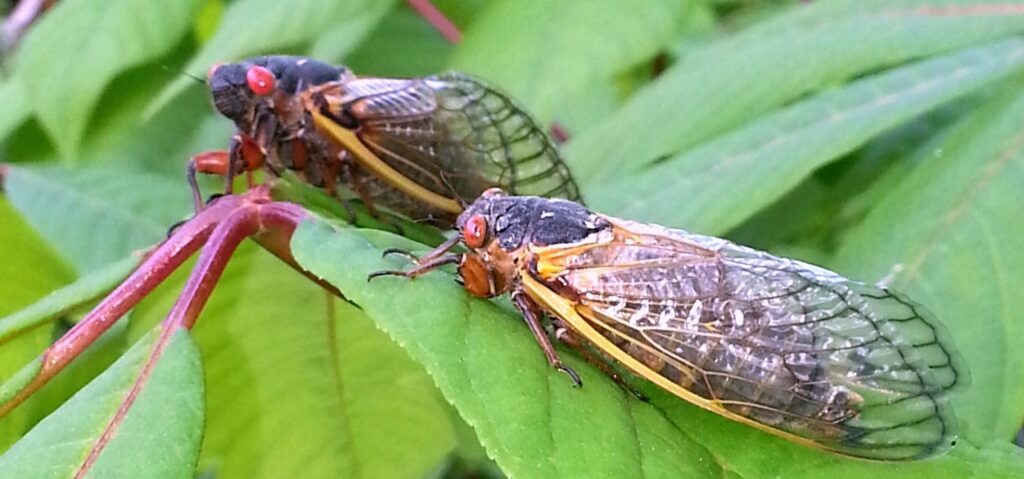The State We're In
Cicadas are coming!
After 17 years of socially distancing underground, billions of “magic” insects are about to come out for a party spreading across swaths of the northeastern United States, including New Jersey. If they’re in your neighborhood, it will get noisy!
These flying insects, periodical cicadas of the genus Magicicada, are known for their bright red eyes and bulky bodies. They emerge every 13 or 17 years for a month of frenzied mating activity, punctuated by the males’ shrill, buzzing chorus.
This year’s group is Brood X (ten), is one of the largest of the 17-year cicada broods. They’re just emerging in parts of 15 states, including New Jersey, Pennsylvania, Delaware and Maryland.
But don’t fear! They don’t bite, sting, carry diseases or eat your plants. They’re not poisonous, so don’t worry if your dog or cat munches on them. In many parts of the world people eat them, and they’re said to taste like canned asparagus. Now’s your chance to enjoy them for the weird and wonderful phenomenon that they are!
Cicadas are considered beneficial because they aerate the ground, provide a banquet for birds and mammals, and contribute nutrients to the soil after they die.
Periodical cicadas have been around for millions of years and were known to Native Americans before the arrival of the first Europeans. Pilgrims at Plymouth Colony spotted them in 1634 and mistook them for locusts, as in the Biblical plagues. Brood X was first reported in 1715 in Philadelphia, but may no longer appear in the city.
If you’re not a fan of bugs, you may be surprised to learn that periodical cicadas have a big following. There are cicada websites, cicada social media pages and even merchandise like t-shirts and coffee mugs. On the scientific side, you can track their progress, report sightings, and post photos and videos on apps like iNaturalist and Cicada Safari. Periodical cicadas should not be confused with annual cicadas, which appear later in the summer.
The current members of Brood X hatched from eggs laid in tree branches back in the summer of 2004, when President George W. Bush was running for his second term. The hatchlings crawled down the trees, burrowed deep into the ground and have been there ever since, sucking fluid from tree roots and growing steadily
When the ground gets warm enough, already happening in some New Jersey locations, the cicada nymphs tunnel their way out to become adults. They’ll climb the nearest trees and shed their exoskeletons. The veins in their wings will fill with fluid, their skin will harden and they’ll be ready to fly. The exoskeletons stay behind – crunchy, translucent shells clinging to tree trunks.
To attract mates, males sing by flexing their tymbals – drum-like organs on either side of the abdomen. At the height of the mating season, their sound can be deafening! After mating, females cut open tender tree branches and deposit their eggs. Soon after, the adults die, having fulfilled their duties. A few weeks later, hatchlings will continue the cycle by burrowing into the earth, not to be seen again until 2038.
Why do periodical cicadas come out only every 13 or 17 years, but in great numbers? Some scientists think the timing may be a natural defense mechanism. After all, it’s harder for predators to anticipate a food source if it appears at infrequent intervals. And the sheer number of cicadas in the brood ensures that there will be enough survivors to produce the next generation.
Enjoy the fascinating cicada spectacle while it lasts! And know that by protecting New Jersey’s trees and forests, we can make sure that Brood X has places to safely re-emerge in 17 years.
To learn more about periodical cicadas, go to the University of Connecticut website at https://cicadas.uconn.edu or www.cicadamania.com. At the latter site, you’ll find fun facts, cicada history and even a cicada bingo game! (One square says, “Saw a dog or human eat a cicada.”)
To report cicada sightings in your area, download the iNaturalist or Cicada Safari apps to your smartphone. You can also check the iNaturalist and Cicada Safari websites to see where cicadas have been spotted near you.
And for information about preserving New Jersey’s land and natural resources – including forests that support cicadas – visit the New Jersey Conservation Foundation website at www.njconservation.org or contact me at info@njconservation.org.
About the Authors
Alison Mitchell
Co-Executive Director
John S. Watson, Jr.
Co-Executive Director
Tom Gilbert
Co-Executive Director, 2022-2023
Michele S. Byers
Executive Director, 1999-2021
View their full bios here.
Filter
Get The Latest News
From The Garden State
In the
News

